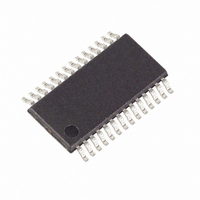MAXQ3181-RAN+ Maxim Integrated Products, MAXQ3181-RAN+ Datasheet - Page 54

MAXQ3181-RAN+
Manufacturer Part Number
MAXQ3181-RAN+
Description
IC AFE POLYPHASE LO-PWR 28-TSSOP
Manufacturer
Maxim Integrated Products
Datasheet
1.MAXQ3181-RAN.pdf
(84 pages)
Specifications of MAXQ3181-RAN+
Number Of Channels
8
Power (watts)
35mW
Voltage - Supply, Analog
3.3V
Voltage - Supply, Digital
3.3V
Package / Case
28-TSSOP
Lead Free Status / RoHS Status
Lead free / RoHS Compliant
Number Of Bits
-
Low-Power, Active Energy, Polyphase AFE
Regardless of the internal units used, VOLT_CC and
AMP_CC can be tailored so that the LSB of the virtual
register can be any value. For example, if one wished
to have a 32-bit value representing milliamps, one
could multiply by a value that scaled the register such
that the LSB was 2
16 bits. The result is milliamps with 32 bits of precision;
thus, the maximum current that could be represented
would be 4,294,967,296mA, or just over 4MA.
The VOLT_CC and AMP_CC values can be calculated
from the full-scale voltage or full-scale current and the
desired value of one LSB in the display register:
Example: Assume the full-scale current is 102.4A, and
that we desire a 1nA LSB. The calculation would pro-
vide an AMP_CC value of:
The MAXQ3181 measures energy. But power is just
energy per unit time, and the MAXQ3181 keeps track of
the time unit over which energy is accumulated. This is
simply the NS value, the fractional number of samples
that comprises one DSP cycle. So converting energy to
power is as simple as dividing the accumulated energy
over one DSP cycle by NS. Multiplying by a conversion
constant (PWR_CC) gives power in user-established
units.
The power registers (PWRP.A, PWRP.B, PWRP.C,
PWRS.A, PWRS.B, PWRS.C) are calculated by multiply-
ing the accumulated energy (A.ACT, A.APP, B.ACT,
B.APP, C.ACT, C.APP) by the conversion coefficient
(PWR_CC) and then dividing by NS. The result is the
48-bit average power over the most recent DSP cycle,
in units established by the conversion coefficient.
The PWR_CC value can be calculated from the full-
scale voltage, the full-scale current, and the desired
value of one LSB in the display register:
Example: For this example, assume the full-scale cur-
rent is 102.4A, the full-scale voltage is 558.1V, and that
the desired LSB is milliwatts after discarding the 16
54
______________________________________________________________________________________
102.4/(2
VOLT CC
PWR CC
AMP CC
24
_
_
_
-16
x 10
mA. Then, discard the low-order
=
=
=
-9
2
2
2
) = 6104 = 0x17D8
32
24
24
I
FS
×
×
×
VOLT LSB
AMP LSB
PWR LSB
I
V
×
FS
FS
V
FS
_
_
_
Power
LSB; that is, the desired LSB is 2
the following calculation:
Power factor is calculated as real power divided by
apparent power. Apparent power is computed as the
product of the RMS voltage and current measurement.
The power factor is multiplied by 2
ed; thus, unity power factor is given by 16,384 decimal
(0x4000).
The line frequency is derived directly from the mean NS
values over the three phases. It is reported as millihertz;
thus, a 50Hz line frequency is reported as decimal
50,000 (0xC350).
Energy is read as the net energy directly scaled from
the appropriate registers. For example, the energy read
from the ENRP.A register (real energy, phase A) is
composed of the difference between the A.EAPOS (real
energy, positive direction, phase A) and A.EANEG (real
energy, negative direction, phase A) registers scaled
by the ENR_CC register.
Note that the energy registers (ENRP.A, ENRP.B,
ENRP.C, ENRP.T, ENRS.A, ENRS.B, ENRS.C, ENRS.T)
represent the energy, in every case, since the last over-
flow event. For this reason, software must keep track of
overflow and make adjustments accordingly when using
this register set.
To calculate the ENR_CC register value, begin with the
full-scale voltage and full-scale current, the frame time,
and the desired LSB value for energy. Then perform the
following calculation:
Example: It is essential to ensure that the correct units
are maintained throughout the calculation. In this exam-
ple, assume that the full-scale voltage is 558.1V, the
full-scale current is 102.4A, the frame time is the default
of 320μs, and the desired LSB is 100 milliwatt-hours
after the 32 bits are discarded; that is, the LSB is 0.1 x
2
given in microseconds and must be converted to hours
before the calculation can be performed: 320μs is 88.9
x 10
102.4 x 558.1 x 88.9 x 10
-32
102.4 x 558.1/(2
-9
watt-hours. Notice, however, that the frame time is
hours. So the calculation proceeds as follows:
ENR CC
_
32
x 2
=
0x0D01
-16
2
-9
I
FS
16
/(2
x 10
×
×
16
V
ENR LSB
FS
x 0.1 x 2
-3
-16
) = 872 = 0x0368
14
×
_
milliwatts. Perform
before it is report-
t
FR
Line Frequency
Power Factor
-32
) = 3329 =
Energy











